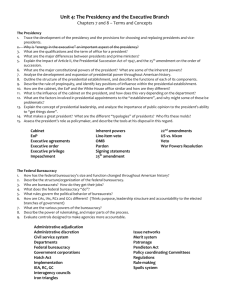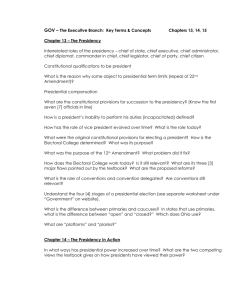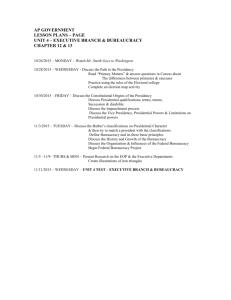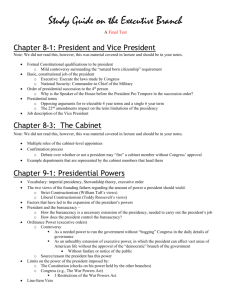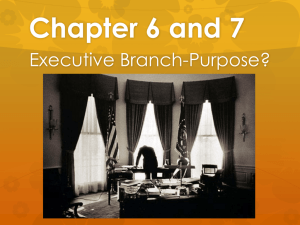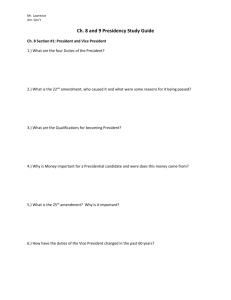Exec Branch Study Guide
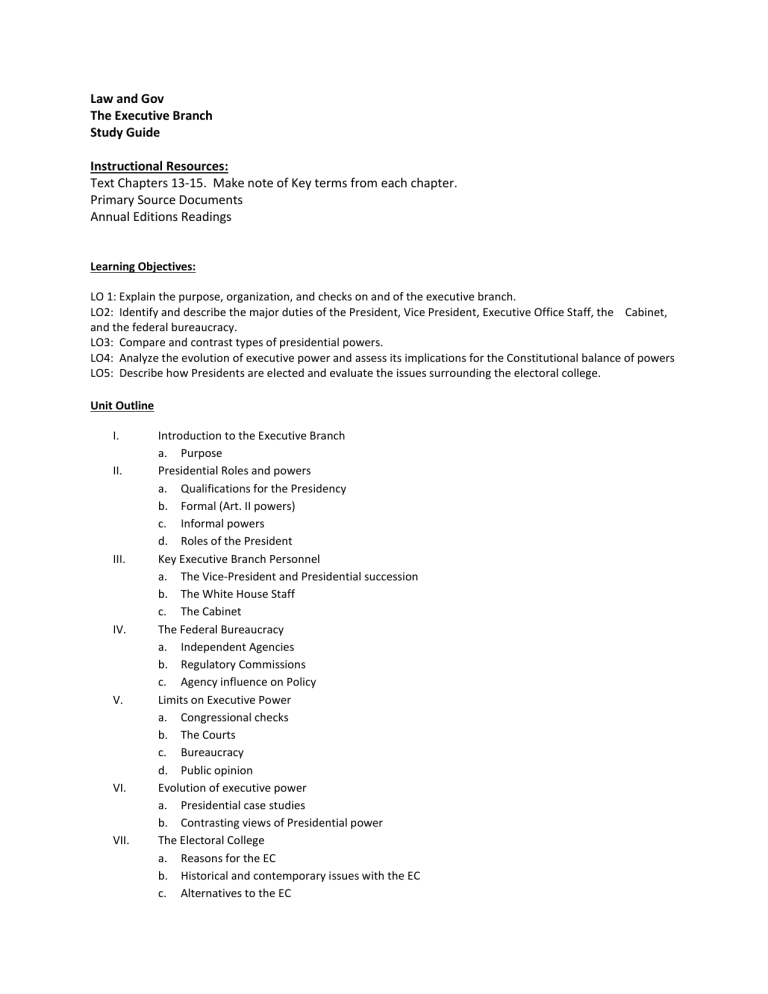
Law and Gov
The Executive Branch
Study Guide
Instructional Resources:
Text Chapters 13-15. Make note of Key terms from each chapter.
Primary Source Documents
Annual Editions Readings
Learning Objectives:
LO 1: Explain the purpose, organization, and checks on and of the executive branch.
LO2: Identify and describe the major duties of the President, Vice President, Executive Office Staff, the Cabinet, and the federal bureaucracy.
LO3: Compare and contrast types of presidential powers.
LO4: Analyze the evolution of executive power and assess its implications for the Constitutional balance of powers
LO5: Describe how Presidents are elected and evaluate the issues surrounding the electoral college.
Unit Outline
I.
II.
III.
IV.
V.
VI.
VII.
Introduction to the Executive Branch a.
Purpose
Presidential Roles and powers a.
Qualifications for the Presidency b.
Formal (Art. II powers) c.
Informal powers d.
Roles of the President
Key Executive Branch Personnel a.
The Vice-President and Presidential succession b.
The White House Staff c.
The Cabinet
The Federal Bureaucracy a.
Independent Agencies b.
Regulatory Commissions c.
Agency influence on Policy
Limits on Executive Power a.
Congressional checks b.
The Courts c.
Bureaucracy d.
Public opinion
Evolution of executive power a.
Presidential case studies b.
Contrasting views of Presidential power
The Electoral College a.
Reasons for the EC b.
Historical and contemporary issues with the EC c.
Alternatives to the EC
The Growth of Presidential Power: Text Ch 14
Objectives:
Explain why article II of the Constitution is considered the “executive Article.
Explain why article II of the Constitution can be described as an “outline.”
Identify and explain several reasons for the growth of presidential power.
Analyze the views and actions of past presidents that have led to the growth of Presidential power.
Terms:
Executive Article
Imperial Presidency
Resources: Text, pp. 390-392
Power and the Presidency, From Kennedy to Obama http://www.smithsonianmag.com/history/power-and-the-presidency-fromkennedy-to-obama-75335897/
Expanding Presidential Power – Two Views (Handout)
Activity: Structured Academic Controversy: Does the President Have Too Much Power?
The President’s Executive Powers
Objectives:
Identify the source of the President’s executive power
Identify the source of the President’s ordinance power.
Analyze the controversy regarding signing statements.
Explain how and why President’s use executive orders.
Explain how the appointment power works.
Summarize the historical debate over the removal power.
Terms:
Oath of office
Executive order
Signing statement
Ordinance power
Appointment and removal powers
Recess appointments
Executive Privilege
Resources: Text, pp. 393-397
“Face the Issues,” p. 398
Obama planning to use executive orders to continue reforms for contracting workforce http://www.washingtonpost.com/politics/obama-planning-to-use-executive-orders-tocontinue-reforms-for-contracting-workforce/2014/04/06/d62ddde6-bda8-11e3-b574f8748871856a_story.html
Activity: Presidential Power: THE SIGNING STATEMENT
Diplomatic and Military Power
Objectives:
Explain how treaties are made and approved
Explain why and how executive agreements are made
Summarize for what purposes the power of recognition is used, and give historic examples
Describe the powers that the President has in the role of commander in chief
Describe how the War Powers Resolution of 1973 attempts to restrict Presidential power
Terms:
Treaty
Executive agreement
Recognition
Persona non grata
Congressional “force” Resolutions
Resources: Text, pp. 399-404
Fact Sheet: The U.S.-Afghanistan Strategic Partnership Agreement http://www.whitehouse.gov/the-press-office/2012/05/01/fact-sheet-us-afghanistanstrategic-partnership-agreement
What is an Executive Agreement? http://www.wisegeek.com/what-is-an-executive-agreement.htm
Legislative and Judicial Powers
Objectives:
Describe the President’s message power
Describe the President’s veto power
Explain how the President’s legislative powers are an important part of the system of checks and balances
Describe the President’s major judicial powers
Terms:
Line-item veto
Reprieve
Pardon
Clemency
Commutation
Amnesty
Resources: Text, pp.405-408
Court Strikes Down Line Item Veto http://www.washingtonpost.com/wpsrv/national/longterm/supcourt/stories/wp062698.htm
Case Study: Korematsu v. United States (handout)
Study Materials:
Text: Magruders, Chapter 15
Power Point: Bureaucracy (located on the lesson plans page)
Objectives:
• What is a bureaucracy?
• What are the major elements of the federal bureaucracy?
• How are groups within the federal bureaucracy named?
• What is the difference between a staff agency and a line agency?
• What is the Executive Office of the President?
• What are the duties of the White House Office and the National Security Council?
• What are the additional agencies in the Executive Office of the President that assist the
President?
• What are the origins of the executive departments, and how did they develop?
• How are members of the Cabinet chosen?
• What role does the Cabinet play in the President’s decisions?
• Why does the government create independent agencies?
• What are the characteristics of independent executive agencies and independent regulatory commissions?
• How are government corporations structured?
• How did the civil service develop?
• What are the characteristics of the current civil service?
• What restrictions are placed on the political activity of members of the civil service?
Terms
Bureaucracy
Bureaucrat
Cabinet
Civil service
Competitive service
Congressional oversight
Discretionary authority
Domestic affairs
Executive Departments
Executive Office of the President
Excepted service
Federal budget
Fiscal year
Independent agencies
Government corporation
Iron triangle
Issue networks
laissez – faire line agency merit system national performance review
Office of Personnel Management
Pendleton Act
Red tape
Spoils system
Staff agency
Critical Thinking
How might a strong, entrenched bureaucracy weaken the power of elected representatives?
How does the Office of Management and Budget enhance the president’s ability to perform his role as chief administrator?
Economist Milton Friedman called bureaucracy, “…both a vehicle whereby special interests can achieve their objectives and an important special interest in its own right.” What doe Friedman mean? What can government do to minimize the situation Friedman describes?
How and why does the government limit the political activities of members of the civil service? Explain whether you would change any of these limits and why, or why not.

